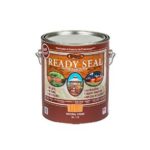Stain is something that can transform a piece of wood into a beautiful piece of art. Mostly used for interior decor, it can also be applied to wood used outside the house. It helps protect the wood by giving it an extra layer on top and making it look much nicer.
Stain has been the standard for finishing a variety of wood products. It is the most affordable option as opposed to painting or varnishing.
Even in our modern age of high-quality paints, stains are still widely used. The method to apply stain is a lot like painting and you have a number of choices besides just using a brush.
There are spray cans or aerosol as well as liquid stain pens which can be used on shutters, trims, and even walls. this article explains how long it will take for your timber to dry fully based on the type of wood along with various other factors.
Below we will walk you through the details on how to apply stain while keeping an eye on drying time and how it all plays into staining wood furniture successfully.
Factors That Affect The Drying Time
Stains can take different amounts of time to dry because the drying time depends on various factors.
These factors include:
Circulation
The circulation in the room will affect the drying time of the stain. The more air circulating in the house, the quicker the drying process will be.
It is common you will find that professionals will come with a number of fans to the workstation to speed up the drying process. If you want to reduce the drying time without compromising the integrity of the polyurethane or stain, adding some fans to the room can have a huge impact.
Other than fans, you can open up the windows of the house to increase air circulation.
It is also worth noting that having a fan and opening the windows will help remove and reduce toxic fumes from your work environment. There is no problem associated with ensuring that the workspace has plenty of air circulation.
Humidity
The process of stain drying is highly influenced by the evaporating moisture from the stain. As the moisture continues to evaporate in the atmosphere, the drying process begins. The reality is that the moisture cannot evaporate quickly in humid areas. Working in conditions with high levels of humidity will double the time the stain takes to dry.
Humidity can cause a lot of frustration since it can have a huge impact on drying time.
If it is possible, try applying the stain in lower humid conditions or postpone the project to a less humid day.
If you plan to go ahead and carry on with the project on a humid day, be prepared to spend extra hours for both the stain and the polyurethane to dry.
Humid conditions can also result in a cloudy look in the poly topcoat. The clouding process occurs when moisture from the poly is unable to release itself into the air before the poly dries up.
Sometimes, an additional poly topcoat can ‘burn in’ to the coat underneath it to free up the moisture trapped and allow it to dry clear. At other times, one can simply wait it out and the cloudiness will eventually disappear when the humid conditions decrease.
Temperature
The temperature conditions of the room you are working on adversely affect the drying time of a stain. In most cases, polyurethane can be applied at a temperature range of 50 to 90 degrees Fahrenheit.
However, you can expect the drying time to be longer if you are at the high or low end of that spectrum.
The ideal temperature for a stain to dry is 70 to 75 degrees Fahrenheit. If the room temperature conditions are higher than that, you will have to account for some extra drying time.
Brand
The brand of the stain you are using will affect the drying time. Some brands claim to have a drying time of 6 to 12 hours.
Depending on the brand and the specific product, the average drying time indicated can vary in a significant way and you will have to account for that when carrying out your staining project.
Types of Stains
Oil-Based Stains
When it comes to oil stains, several factors affect the drying time. The drying time will vary because they come in gel, liquid, and aerosol forms. Some brands will dry in just a few hours.
However, most oil-based stains will require from a few hours to 24 hours to dry. For instance, one can add another coat in 8 hours, in contrast to other types of gel that need 24 hours before adding polyurethane.
Water-Based Stains
One thing you have to know is that water-based stains take a shorter time to dry as compared to their oil-based counterparts. The factor that makes the drying time for the water-based stain to dry faster is because it does not contain any sort of oils in it.
Water-based stains will take anywhere from 1 to 3 days to be fully dried up and then you can add the polyurethane layer. Water-based stains can take about 3 hours to dry especially when painted on wood.
If you’re new to staining wood, be sure to check out our guide on the best stain for cedar, which will go over the different kinds of stains you can use for your cedar projects.
Minwax Oil-Based Stains
Minwax Oil-Based Stains are known to provide a rich color that enhances the aesthetics of the wood. This type of stain will take around 2 hours to dry out. You need to give it at least 8 hours before recoating.
After recoating, the drying time will vary according to the brand used. It can range from 2 hours to 12 hours, respectively.
Varathane Stains
Varathane is a stain that brings the best out of natural wood. Its drying time is affected by factors such as humidity levels as well as the current temperatures. In the right conditions, it can dry to the touch in about 2 hours and can be recoated after another 2 hours.
You should allow the Varathane premium stain to dry for about 8 hours before applying the oil-based finish or 24 hours before applying a water-based finish. It offers different stains just like Minwax.
With temperatures of about 80 degrees and humidity of 50%, the drying time will be quite friendly.
Varathane Standard Stains
Varathane standard stain will give the wood a custom look and blend with many colors. You can bring out a perfect shade by combining two colors in a one-to-one ratio. For this reason, it is referred to as a premium stain. It will take about 2 hours to dry before an additional coat is added.
Varathane Gel Stains
The stain is thick and gives a double coverage of traditional oil-based stains. It prevents any kind of drip while enhancing the patina and wood grain.
It is perfect for vertical areas because it does not drip. It does not have any lap marks whatsoever. The Varathane gel stains will take 2 hours to dry before another layer is added. Give it another 8 hours before applying polyurethane.
Behr Oil-Based Stain
Behr Oil-Based Stain gives a rich color and control to the interior design of your wood satin project. The unique oil formula can be applied in a variety of areas to provide a warm look to your interior wood surface.
It allows one to apply it on multiple surfaces and substrates that include wood, metal, and fiberglass. The Behr oil-based stain can dry in about 2 hours and then another layer can be applied. For the stain to be completely cured, it will require approximately 3 days.
Cabot Oil-Based Stains
The Cabot oil-based stains can beautify the wood exterior while at the same time protecting it. The stain enhances the natural beauty of the wood by allowing the texture, grain, and color variation within the wood to show through.
It combines the properties of oil-based with easy-to-clean water-based finishes that make the exterior wood surface more beautiful. This stain does not fade quickly and its tone will last for an extended period.
Osmos Stains
Osmo stains can dry in about 12 hours at temperature conditions of 73.4 degrees Fahrenheit and 50% humidity. The drying time may take more than 12 hours if the temperature is lower and humidity gets higher.
General Finishes Wood Stain
It will take around 4 hours for the general finishes wood stain to dry under ideal conditions of temperatures ranges of 70 degrees and 70% humidity. High levels of humidity and cooler temperatures will extend the drying time.
On the contrary, air circulation and higher temperatures will make the drying process quicker and more effective.
Minwax Water-Based Stain
The Minwax water-based stain takes about 2 hours before you can apply the second coat. In ideal conditions, the stain will dry in 3 hours. The drying time can extend if the temperature is low, humidity levels are high, and if there is a heavy application.
The good thing is that Polyurethane can be applied after the stain is all dry.
Frequently Asked Questions
How Long to Let Oil-Based Stains Dry Before Polyurethane?
Different type of stains takes varying time duration to dry before you can apply polyurethane. Oil-based stains have the following drying times:
| Types of Stains | Drying Time |
|---|---|
| Minwax oil-based stains | It depends on the types of stains used: aerosol, liquid, gel form, and standard and performance stains. It takes 8 hours before putting a second layer. Depending on the brand used, the time varies from 2 to 12 hours after recoat. Minwax gel stains take about 8 to 10 hours before putting a recoat. It takes more time to dry, nothing less than 24 hours. |
| Varathane stains | It takes at least 8 hours before applying a topcoat. |
| Osmo stains | It takes more than 12 hours to dry. |
| Cabot stains | It needs at least 24 hours to dry. |
| Behr oil-based stains | It takes about 2 hours for the stain to dry. Afterward, a recoat can be done. To completely cure, the stain requires at least 72 hours. |
How Long to Let Water-Based Stains Dry Before Polyurethane?
Water-based stains dry faster than oil-based stains. Minwax water-based stains take about 3 hours to dry, after which a recoat is applied. General finishes wood stain takes 3-4 hours to dry.
Wait for about 24-48 hours before applying the polyurethane. You can add more time to ensure is completely dry.
How Long Does It Take a Wood Stain to Dry?
There are different types of exterior wood stains with varying drying times. Thick penetrative stains form a seal when applied to the wood. It dries quickly on the top but takes 24 to 48 hours to dry.
Stains that do not penetrate the wood take a week or two to dry and be ready for a second layer. Latex stains take up to 2 to 3 weeks to dry.
How Long Does Interior and Exterior Stains Take to Dry?
Interior and exterior stains face different environmental factors hence varying drying times. Interior stains experience warmer air which can be limited with lower humidity levels. This makes interior paints take about 6 to 24 hours to dry.
The exterior stains experience fluctuating temperatures with a difference of 20 degrees Fahrenheit. The stain also faces high humidity at night and early morning. This makes the stain take about 24 to 72 hours to dry.
What Goes on When You Apply the Polyurethane Before the Stain is Completely Dry?
Generally, polyurethane is applied when the stain dries. If you apply it before you are sure it dries, you will make a mess. The stain will mix with the poly and will take a very long time to dry. A poly layer on a wet stain reduces the bonding ability of the poly ending up with a poor finish.
How Long Should the Stain Dry Before the Rain?
The rule is, no rain 24 hours before applying the stain, and no rain for 48 hours after staining. Such an environment ensures that the surface is thirsty for the stain, and dries well without interference.
How Do You Fix Staining Mistakes?
- The first thing you do is to identify the problem at hand before starting to fix it.
- Start by applying another layer of stain on an uneven color area.
- To fix the irregular shade, apply a thinner.
- To even out, smear another layer of wood stain.
- Sand-stained wood to start again.
- Fix blotchy wood stain by sanding and gel stain.
- For sticky wood stain, you can fix it by using stain thinner and applying more stain.
- Fix the non-penetrating stains.
- To fix streaks and drips, apply mineral spirit to the stained wood.
- Chemical stain stripper use.
What Temperature is Ideal for Staining a Deck?
The optimum temperature for staining is 70 degrees Fahrenheit. A range of 50-90 degrees Fahrenheit is considered safe. Always check the label first and avoid high humidity or staining on hot surfaces.
Can You Stain Wood in Direct Sunlight?
Many people assume that they can stain their deck in direct sunlight, but this can actually be counterproductive. The heat from the sun will cause the deck to dry out more quickly, which can leave watermarks. It is best to wait for a cooler day when the temperature is below 80 degrees Fahrenheit.
This will give the stain plenty of time to absorb into the wood without drying out too quickly. If you do stains your deck in direct sunlight, be sure to move around often so that you don’t miss any spots. Taking these precautions will ensure that your deck looks its best.
Can You Leave a Stain Without Wiping?
At the staining stage, there is no build, hence no risk is posed. However, you can’t spray a dye and leave it without wiping since you will not have a fine-grain definition. To attain the best grain definition, use an oil stain or over the sealer coat after the dye has dried, and wipe the excess.
Conclusion
With today’s modern finishes and finishing techniques, the drying time for stains has decreased immensely compared to older methods. Depending on the type of stain you are using, the drying time can be as short as a few hours or as long as a few days.
From the information gathered in this article, it is important to understand that before the application of polyurethane, you should allow the stain to dry well and avoid mixing the stain into your polyurethane.
In some cases, it may result in a poor finish as a result of the reduced boding ability of the poly to the stain.



